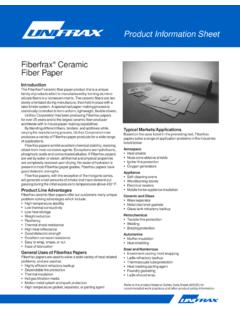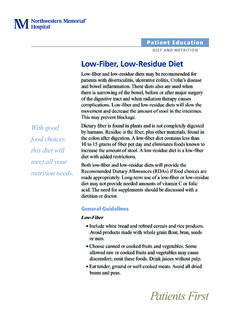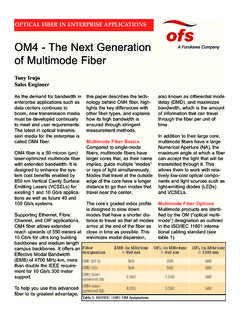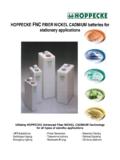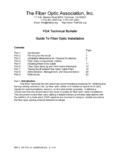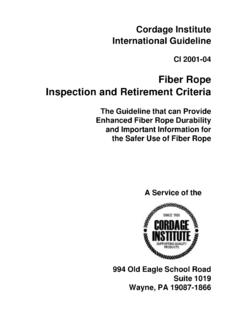Transcription of Material Safety Data Sheet - Ceramic Fiber
1 Material Safety data Sheet 1. CHEMICAL PRODUCT AND COMPANY IDENTIFICATION Product Name: Ceramic Fiber Textile (Cloth, Tape, Twisted Rope, Round Braid, Square Braid, Sleeving, Yarn) Chemical Name: Aluminosilicate Fiber Trade Name: CeraTex Manufacturer s Name: Mineral Seal Corp. Address (Number, Street, City, State and ZIP code): 7941 E. Lakeside Pkwy, No. 114 Tucson, AZ. 85730 Emergency Telephone Number: (520) 885- 8228 Telephone Number for Information: (520) 885 - 8228 Revision Date: 10/15/05 2. COMPOSITION / INFORMATION ON INGREDIENTS Components CAS Number %(By Weight) Aluminosilicate Ceramic Fiber 142844-00-6 85% (A1203 48%, A1203+ Si02 97%)
2 Other components: Fiber glass, Viscose rayon N/D 15% 3. HAZARDS IDENTIFICATION Route(s) of Entry: Respiratory Tract (nose & throat), Eyes, Skin POSSIBLE CANCER HAZARD BY INHALATION Acute and Chronic Health Hazards: No increased incidence of respiratory disease in studies on occupationally exposed workers. In animal studies, long-term laboratory exposure to doses hundreds of times higher than normal occupational exposures has produced fibrosis, lung cancer, and mesothelioma in rats or hamsters.
3 The fibers used in those studies were specially sized to maximize rodent respirability. Other Possible Effects: Inhalation: If inhaled in sufficient amount, it may cause irritation to respiratory tract, scratchiness of the nose or throat, cough or chest discomfort. Eye Irritation: May cause eye irritation by contact may cause damage to the outer surface of the eye. Skin Irritation: May cause skin irritation by contact, may also result in inflammation, rash or itching. Gastrointestinal Irritation: Unlikely route of entry. Medical Conditions Aggravated by Exposure: Asthma, dermatitis, allergies, or chronic lung disease may be aggravated by exposure 1 HAZARD CLASSIFICATION In the following cases, hazard classification are based on results from animal testing.
4 The conclusions are qualitative only and do not rest upon any quantitative analysis suggesting that the hazard actually may occur at current occupational exposure levels. In October 2001, the International Agency for Research on Cancer (IARC) confirmed that Group 2b (possible human carcinogen) remains the appropriate IARC classification for RCF including Ceramic Fiber . Possible cancer hazard by inhalation, especially when the Fiber become cristobalite at high temperature above 1,800 F. The Seventh Annual Report on Carcinogens (1994), prepared by the National Toxicology Program (NTP), classified respirable RCF and glasswool as substances reasonably anticipated to be carcinogens.
5 The American Conference of Governmental Industrial Hygienists (ACGIH) has classified RCF as "A2-Suspected Human Carcinogen." The Commission of The European Communities (DG XI) has classified RCF as a substance that should be regarded as if it is carcinogenic to man. The State of California, pursuant to Proposition 65, The Safe Drinking Water and Toxic Enforcement Act of 1986, has listed " Ceramic fibers (airborne fibers of respirable size)" as a chemical known to the State of California to cause cancer. The Canadian Environmental Protection Agency (CEPA) has classified RCF as "probably carcinogenic" (Group 2). The Canadian Workplace Hazardous Materials Information System (WHMIS) RCF is classified as Class D2A Materials Causing Other Toxic Effects The Hazardous Materials Identification System (HMIS) Health 1* Flammability 0 Reactivity 0 Personal Protection Index: X (Employer Determined) (*potential for chronic effects) 4.
6 FIRST AID MEASURES 2 RESPIRATORY TRACT IRRITATION: Move the person to a dust free location. Get medical attention if the irritation continues. EYE IRRITATION: Flush with large amounts of water. Eyelids should be held away from the eyeball to ensure thorough rinsing. Do not rub eyes. Get medical attention if irritation persists. SKIN IRRITATION: For skin irritation, remove soiled clothing. Do not rub or scratch exposed skin. Wash area of contact thoroughly with soap and water. Using a skin cream or lotion after washing may be helpful. GASTROINTESTINAL IRRITATION: Unlikely to happen. However, if gastrointestinal tract irritation develops, move the person to a dust free environment.
7 NOTES TO PHYSICIANS: Skin and respiratory effects are the result of temporary, mild mechanical irritation; Fiber exposure does not result in allergic manifestations. 5. FIRE FIGHTING MEASURES NFPA Unusual Hazards: None Flammable Properties: None Flash Point: None Hazardous Decomposition Products: None Unusual Fire and Explosion Hazard: None Extinguishing Media: Use extinguishing media suitable for type of surrounding fire. NFPA Codes: Flammability: 0 Health: 1 Reactivity: 0 Special: 0 6. ACCIDENTAL RELEASE MEASURES SPILL PROCEDURES Avoid creating airborne dust. Dust suppressing cleaning methods such as wet sweeping or vacuuming should be used to clean the work area.
8 If vacuuming, the vacuum must be equipped with a HEPA filter. Compressed air or dry sweeping should not be used for cleaning. 7. HANDLING AND STORAGE 3 STORAGE Store in original container in a dry area. Keep container closed when not in use. HANDLING Handle Ceramic Fiber carefully. Limit use of power tools unless in conjunction with local exhaust. Use hand tools whenever possible. Frequently clean the work area with HEPA filtered vacuum or wet sweeping to minimize the accumulation of debris. Do not use compressed air for clean-up. EMPTY CONTAINERS Product packaging may contain residue. Do not reuse. 8. EXPOSURE CONTROLS/PERSONAL PROTECTION Exposure Limits: OSHA PEL: N/D Manufacturer/Supplier Suggested Limit: f/cc, 8-hr.
9 TWA Mechanical Controls: local exhaust ventilation, dust collection, and other equipment designed to minimize airborne Fiber emissions Personal Respiratory Protection Equipments: When exposure is under f/cc, respiratory protection equipment is optional. When exposure is above limit, half -facepiece, or full-facepiece air purifying respirator equipped with a NIOSH certified P100 particulate filter cartridge or PAPR with tight-fitting full facepiece is recommended depending on the exposure level. Skin Protection: Wear gloves, head coverings and washable or disposable full body clothing as necessary to prevent skin irritation. clothing may be used. Wash work clothing separately.
10 Minimize or avoid non-work dust. Eye Protection: Wear Safety glasses with side shields or other forms of eye protection in compliance with appropriate OSHA standards. Do not touch eyes with soiled body parts or materials. For more information, please contact manufacturer/supplier. 9. PHYSICAL AND CHEMICAL PROPERTIES 4 ODOR AND APPEARANCE: White, odorless, fibrous materialCHEMICAL FAMILY: Vitreous Aluminosilicate Fibers BOILING POINT: N/A WATER SOLUBILITY (%): Not Soluble in Water MELTING POINT: 1760 C (3200 F) SPECIFIC GRAVITY: VAPOR PRESSURE: N/A pH: N/A VAPOR DENSITY (Air = 1): N/A % VOLATILE: N/A MOLECULAR FORMULA: N/D 10. STABILITY AND REACTIVITY CHEMICAL STABILITY: Stable under conditions of normal : Soluble in hydrofluoric acid, phosphoric acid, and concentrated alkali.
